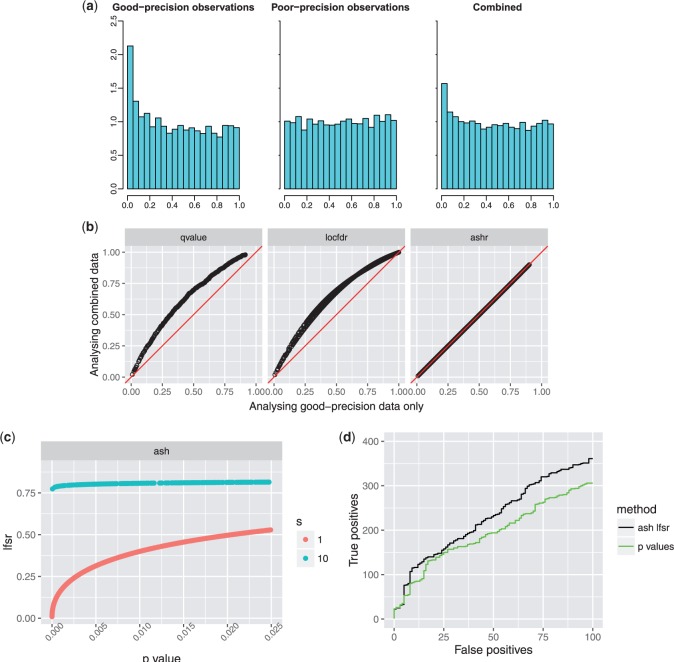Fig. 4.
Simulations showing how, with existing methods, but not ash, poor-precision observations can contaminate signal from good-precision observations. (a) Density histograms of  values for good-precision, poor-precision, and combined observations. The combined data show less signal than the good-precision data, due to the contamination effect of the poor-precision measurements. (b) Results of different methods applied to good-precision observations only (
values for good-precision, poor-precision, and combined observations. The combined data show less signal than the good-precision data, due to the contamination effect of the poor-precision measurements. (b) Results of different methods applied to good-precision observations only ( -axis) and combined data (
-axis) and combined data ( -axis). Each point shows the “significance” (
-axis). Each point shows the “significance” ( values from qvalue;
values from qvalue;  for locfdr;
for locfdr;  for ash) of a good-precision observation under the two different analyses. For existing methods including the poor-precision observations reduces significance of good-precision observations, whereas for ash the poor-precision observations have little effect (because they have a very flat likelihood). (c) The relationship between
for ash) of a good-precision observation under the two different analyses. For existing methods including the poor-precision observations reduces significance of good-precision observations, whereas for ash the poor-precision observations have little effect (because they have a very flat likelihood). (c) The relationship between  and
and  -value is different for good-precision (
-value is different for good-precision ( ) and low-precision (
) and low-precision ( ) measurements: ash assigns the low-precision measurements a higher
) measurements: ash assigns the low-precision measurements a higher  , effectively downweighting them. (d) Trade-off between true positives (
, effectively downweighting them. (d) Trade-off between true positives ( ) vs false positives (
) vs false positives ( ) as the significance threshold (
) as the significance threshold ( or
or  value) is varied. By downweighting the low-precision observations ash re-orders the significance of observations, producing more true positives at a given number of false positives. It is important to note that this behaviour of ash depends on choice of
value) is varied. By downweighting the low-precision observations ash re-orders the significance of observations, producing more true positives at a given number of false positives. It is important to note that this behaviour of ash depends on choice of  . See Section 3.2.1 for discussion.
. See Section 3.2.1 for discussion.

